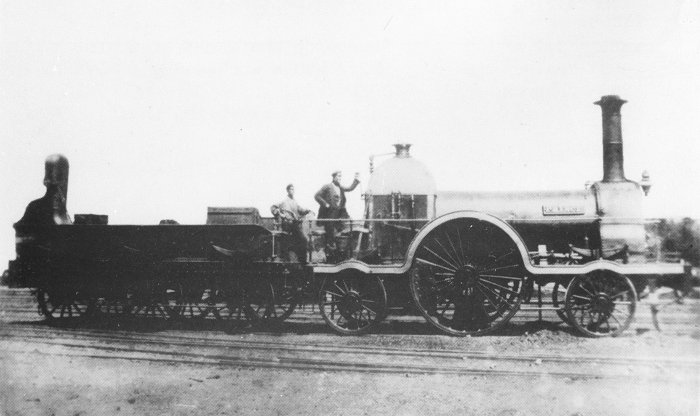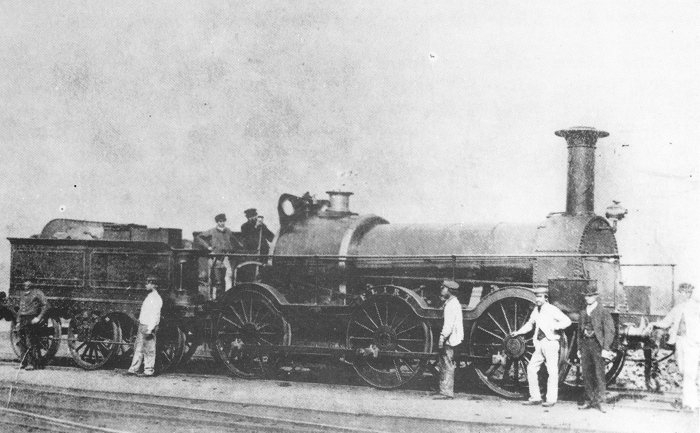Wolverhampton Based
Locomotives, 1854 - 69
|
When the G. W. R. acquired the two
Shrewsbury companies in 1854 it also came to own its first
stretch of "narrow gauge" main line, and a collection of similar
gauged locomotives of various shapes and sizes. The G. W. R.
entered Wolverhampton over metals belonging to the
Oxford, Worcester and Wolverhampton Railway, the G.W.R.
main-line from the south ending at a junction at "Priestfield
Furnaces", where a small ticket collecting platform was set up.
The O.W.W.R. was forced by Parliament to lay mixed gauge rails
for the benefit of G.W.R. trains, at least from Dudley through
Priestfield to the jointly owned station at Wolverhampton, later
to be known as "Low Level". The G.W.R. itself laid broad gauge
metals to the north of Low Level as far as the far side of the
viaduct at Oxley, and to a four road engine shed between the
canal and the Stafford Road. Beyond Oxley the line reverted to
narrow gauge and continued towards Wellington and Shrewsbury.
The O.W.W.R. had an engine shed located
close to the tunnel mouth at the south end of the Low Level
station, and G.W.R. broad gauge engines were detached from
"down" trains at the north end of the station. G. W. R. trains
running between Birmingham and Shrewsbury were narrow gauge to
avoid the change of gauge which would otherwise ensue at
Wolverhampton. Initially the narrow gauge did not proceed south
of Birmingham Snow Hill. These arrangements created a locomotive
situation unique on the G.W.R., with the two mile section of
line between Low Level station and junction at Priestfield
playing host to two gauges of G.W.R. locomotives and to the
engines of the O.W.W.R. As if this were not enough, a "real"
narrow gauge (2' 6") industrial railway serving the Chillington
Ironworks Company crossed over the line just south of the tunnel
mouth.
The situation as regards the "narrow gauge"
locomotives is well covered elsewhere (in particular see the
R.C.T.S. "Locomotives of the Great Western Railway" Part Three
"Absorbed Engines"), but details of broad gauge locomotives
working in the area are virtually unknown. Those known to us are
recorded here. (Apologies for the rather vague references for
material gathered years ago). |

“Prince” was a 2-2-2 of the “Prince”
class, built at Swindon in 1846. Notice the “iron coffin”
mounted above the rear of the tender, being the protective
look-out post given to the guard, vigilantly looking back along
the train. These engines are recorded as working the “Birmingham
line” in later years, which, as usual, actually includes the
line as far north as Wolverhampton. “Prince” is recorded as
receiving attention at Stafford Road, and may well have been
regularly stationed there. “Prince” was withdrawn, unrebui1t, in
1870, after the closure of the northern main line to broad gauge
traffic. Courtesy of Real Photos. |
|
Broad Gauge Locomotives
The first broad gauge locomotive working
into our area was recorded in the Birmingham newspapers at the
opening of the line as far as Snow Hill, when we hear that the
"Firefly" class 2-2-2 "Harpy" drew the inaugural train in 1852.
The locomotive "Dreadnought" survived the collapse of a bridge
at Handsworth in August 1854, shortly after the inspection of
the line prior to its opening by Captain Galton. Both locomotive
and train had passed over the bridge moments before its demise.
An inspection by Brunel brought about the reconstruction of
several other bridges, including one crossing the canal before
the approach to Stafford Road at Wolverhampton.
Mr. T. Houghton-Wright wrote an article for
the "Railway Magazine" of October 1898 in which he referred to
the derailment of the 0-6-0 "Ariadne" of the "Caesar" class,
whilst at the head of a Wolverhampton-London goods train in
January 1861. The "Wolverhampton Chronicle" recorded the stately
arrival of Her Majesty Queen Victoria behind the resplendently
decorated 4-2-2 "Lord of the Isles" when she visited the town in
1866. The same newspaper as late as 1906 reviewed a recently
published railway book with the comment that: "The engine "Great
Western" was employed for a good many years in running the
express trains from Paddington to Birmingham. To Wolverhampton
people it formed an important link in their connection with the
Metropolis prior to the abolition of the broad gauge, which Mr
Bennett (the author) shows to have been a mistake".
The most interesting evidence for broad
gauge engines locally is to be found in the book recording the
lists of rolled plans that were once deposited in the works at
Stafford Road. The following plans were recorded appertaining to
broad gauge locomotives:
| October 1859 |
"Salus" |
Reversing shaft and brackets. |
| October 1869* |
"Salus" |
Broad gauge worked on. |
| December 1859 |
"Diana" |
Eccentric. |
| November 1861 |
"Peri" |
Details of reversing shaft. |
| No date |
"Peri" |
Valve motion. |
| No date |
"Woverhampton" |
(proposed stuffing box) |
| 9/1/58 |
"Prince" |
. . . . . . |
| *(Possibly meant to read 1859.) |
|
Even if the date for "Salus" is a mistake,
(and it might not be), it can be seen from the list that "Peri"
at least, (a 2-2-2 of the 1st lot passenger") was a regular
visitor to the works in the 1860s. It is interesting to see that
the goods 0-6-0 "Wolverhampton " is included in the list; it
seems reasonable to believe that she should be allocated to
Stafford Road, (incidentally there have been three steam
locomotives of this name).
The list also mentions a plan under the
"Works Machinery" section for an "Engine truck - 7 ft gauge -
1854 " for use on dismantled locomotives. |

“Flirt” was an 1852 built broad gauge
0-6-0 of the “Ceasar” class, or “4th Lot Goods”. We have no
written evidence that “Flirt” was allocated locally, however,
notice the concentric rings painted around the wheel centres.
Some Bristol and Exeter passenger locomotives carried similar
patterns, but such concentric rings became a distinctive
hallmark of Stafford Road allocated engines, passenger and goods
alike, in the later Victorian age. Were such details part of an
earlier tradition? Photograph F. Moore. |
|
Although these mere nine broad gauge
references are all that may be found among many hundreds of
listed plans relating to standard gauge locomotives, the wording
of the other plans suggest that the broad gauge was not
forgotten at Wolverhampton quite as readily as G.W.R. historians
would have us believe. There is a regular tendency within the
lists, long after the retreat of the seven foot gauge, to refer
to standard gauge engines unnecessarily as "narrow gauge" late
into the 1870s, and occasionally into the 1880s. The works also
produced a plan for converting the buffers of their 0-6-0
saddle-tanks, enabling them to shunt trains of both gauges in
the Southern Division, one such altered engine, "850" class No.
990 being shown in Real Photographs negative No. 15662.
Finally the lists give the identities of
the stationary boilers used within the works. The lists record
the following: "13/9/93 old b.g. boilers Lot 6 Dragon and
Bulkeley" and gives the earlier boilers as belonging to ex B &
ER No 2001 and G.W.R. "Balaclava", in plans dated 25/10/82. The
RCTS records 2001 as withdrawn from stock in December 1877, and
"Balaclava" withdrawn in October 1871. These old boilers were
popular with the men at Stafford Road, as they were excellent
steamers. The original identity of the different boilers was
remembered into the 1930s by those who worked them, though they
gradually became forgotten. |

| An extract from the
Stafford Road book of “Rolled Plans”, reference to
the broad gauge locomotive “Wolverhampton”. |
|
 |
|
 |
|
 |
Return to
The Kings |
|
Return to
the Beginning |
|
Proceed to
Priestfield |
|